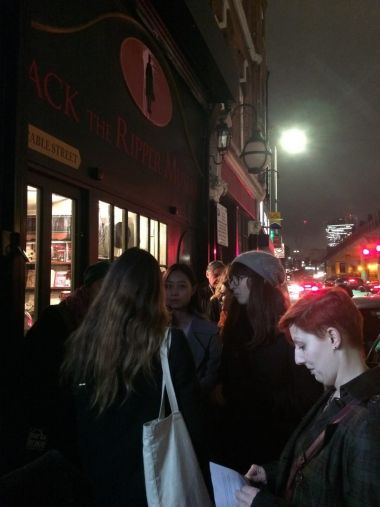East London church holds vigil to honour victims of gender-based violence

A church in East London has committed to portraying the true history of women in the area with an exhibition, after a museum that promised to be "the only dedicated resource in the East End to women's history" has been accused of glamourising the killings of the infamous Jack the Ripper.
St. George-in-the-East, a church in Shadwell, helped to organise a protest vigil outside the new Jack the Ripper Museum and a memorial service for the lives of the women he killed, which took place last night.
A crowd gathered outside the museum on busy Cable Street yesterday evening in a mark of solidarity with Jack the Ripper's five victims and all other women who have suffered gender-based violence. During the vigil, the lives of each of the victims was remembered.
"Those five women have been killed with violence and have not been afforded dignity even in their death, but instead photos of their violated bodies are being displayed for the titillation of thrill seekers," said Bethan Lant, one of the organisers and a congregant at another nearby church - St Mary, Cable Street.
"Those five women are the reason that we are here tonight, plus the hundreds of thousands of nameless women who have also been killed simply because they are women.
"All of those women had lives, they had lovers, they had children. They lived, they walked these streets and they deserve to be remembered as living, breathing human beings, not mutilated corpses. We will remember them and turn our back on this place."
After the vigil, which was interrupted by an angry employee of the museum who grabbed a photographer's camera and had to be restrained by police, those taking part then walked down Cable Street to St. George-in-the-East for the memorial service.
Rather than allow the museum to be the sole voice on the role of women in East London, the church will counter it with an exhibition portraying the true contribution women have made toward the history of Tower Hamlets.

The exhibition hopes to do what the Jack the Ripper museum had promised: to tell the rich and diverse story of its women and their extraordinary courage and resilience.
"Our aim is to celebrate the true history of east London: a place where residents stand up against gender-based violence every day, as they have had to for centuries," Abbie Gillgan, a member of the church, wrote in an article for Christian Today.
These stories include those of the Suffragettes, of Catherine Booth and the Match Girls (who transformed the working conditions in their factory), of female politicians and social reformers such as Minnie Lansbury and Edith Ramsay, and of the women involved in the Battle of Cable Street in 1936.
"It is really positive... to humanise the women and remember them: it's the kind of attitude that the [Jack the Ripper] museum is displaying that results in a violence against women today – objectifying women, treating them as objects with no agency, no dignity, no respect, and that's what leads to gender violence," Lant told Christian Today.
During the memorial service, led entirely by women, Rev Alexandra Lilley shone light on the hope found in the "rebel" and "slave" Jesus Christ (a theme first raised by Sufferagette leader Emmeline Pankhurst).
"The Christian story is a story of God revealed as a rebel: Jesus Christ who comes to turn the social order on its head. The Church is at its best when it remembers this," she said.
"Jesus was not only a rebel, if that's all he was he would just take his place alongside many other noble men and women who have stood up to justice."
But, she added, he was also a slave.
He took "the form of a slave and humbled himself to the point of death, even death on a cross. The outrage of the Christian God is not only that he is a God who suffers with those who suffer, but one who suffers and offers healing for the brokenness that perpetuates violence."
She said, "We look forward in hope for there is one who has gone before us: a rebel who uproots the proud oppressor and exalts the humble and calls us to join in with him, but even more than that Jesus Christ who became a victim and a slave in the place of us so that all of us might be set free."











